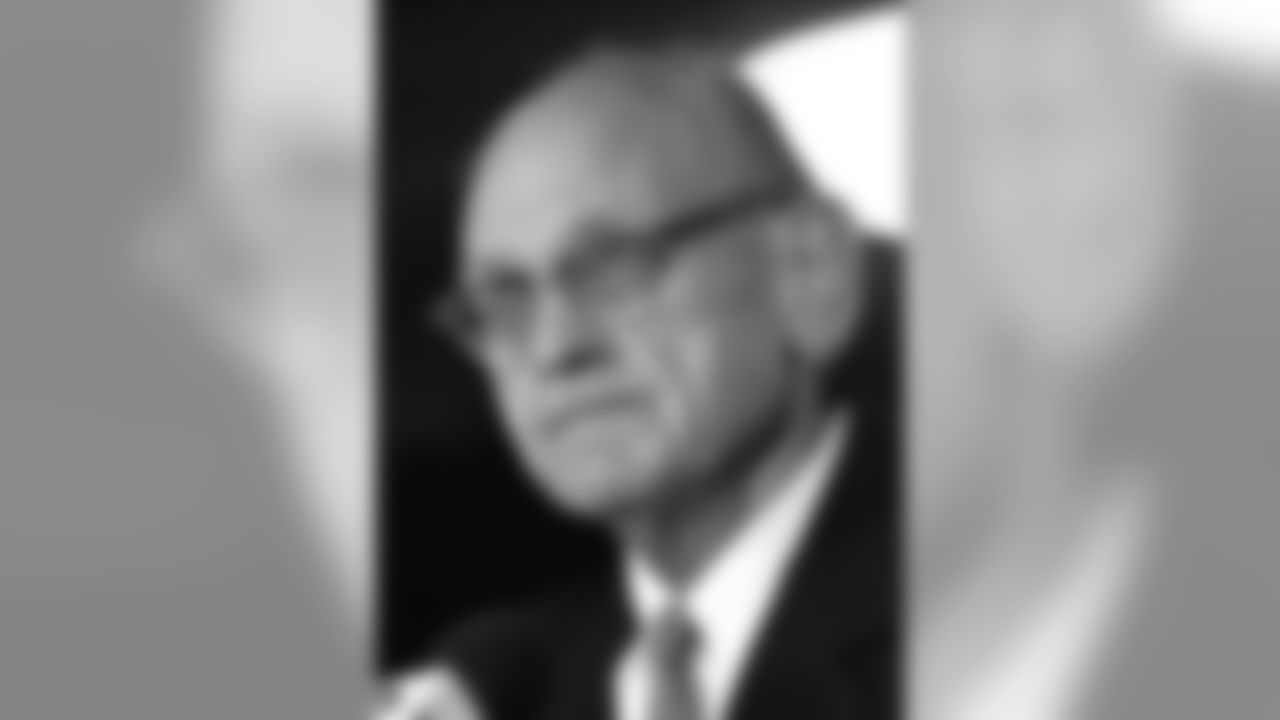EAST RUTHERFORD, N.J. – George Young, one of the most significant and influential non-playing figures in Giants history, is a finalist for the Pro Football Hall of Fame's special Centennial Class of 2020.
Young, the Giants' general manager from 1979-97, is one of 10 contributors – individuals other than a player or coach – selected as a finalist by a special panel comprised of members of the Pro Football Hall of Fame Selection Committee, Hall of Famers, coaches, football executives and several leading historians. Three of the finalists will be elected to the Hall of Fame as part of the Class of 2020.
"He certainly is deserving of enshrinement," said Ernie Accorsi today, who was one of Young's closest friends and his successor as the team's general manager. He would be the absolute definition of a Hall of Fame contributor."
Young, who died in 2001, led the Giants from one of the bleakest periods in their history to one of their most successful eras. After playing in the 1963 NFL Championship Game, the Giants had just two winning seasons and did not make the playoffs in the next 15 years. The futility reached its nadir in 1978 with "The Fumble," Herm Edwards' infamous recovery and touchdown that gave the Philadelphia Eagles a 19-17 victory in Giants Stadium.
Young, who had been the Miami Dolphins' director of player personnel, was hired in February 1979 after NFL commissioner Pete Rozelle offered him as a compromise candidate to the Giants' owners, Wellington Mara and his nephew, Tim, whose relationship had long been fractured.
Young quickly set out to resurrect the moribund franchise. His first draft choice was a little-known quarterback from Morehead State, Phil Simms, who was the franchise's greatest player at the game's most important position before Eli Manning came along. Two years later, Young chose linebacker Lawrence Taylor with the second overall selection in the NFL Draft. When his coach, Ray Perkins, left the Giants after the 1982 season to become the coach at his alma mater, the University of Alabama, Young promoted defensive coordinator Bill Parcells to the top job.
"We both came into the league with Johnny Unitas as the quarterback," said Accorsi, who met Young in 1970, when they worked together for the Baltimore Colts. "We both realized the importance and the impact of a great quarterback. I knew that quarterback was going to be a high priority and I also knew big people were a high priority. He was going to have two lines that were powerful, and he was going to have a quarterback. That's exactly how he started to build the Giants. He believed in big people. That was the way George was."
From 1981-90, Simms, Taylor and Parcells, along with the big people, led the Giants to six playoff berths, three NFC East titles and victories in Super Bowls XXI and XXV. Taylor and Parcells are in the Hall of Fame.
Parcells left the Giants after the 1990 season and the team made the playoffs just once in the next six years, as a wild card in 1993 in Dan Reeves' first season as coach. In 1997, Young replaced Reeves with Jim Fassel and the team won the NFC East championship. After clinching the title with a victory against Washington, Young uncharacteristically walked onto the field, sat alone on the Giants' bench and wept.
He later said of his Giants' tenure: "I've had a wonderful job here. We've had our ups and downs, but I've never had a bad day."
Young was one of the most successful and highly-respected executives in NFL history. Five times, he was named NFL executive of the year (1984, 1986, 1990, 1993 and 1997).
He retired following that '97 season to fill the newly-created position of director of football operations for the NFL under commissioner Paul Tagliabue, who is also a Hall of Fame finalist as a contributor.
Young passed away on Dec. 8, 2001 at age 71 of a rare neurological disorder. At a memorial service 10 days later, Tagliabue called him "one of the finest men our nation has ever produced."
To honor the NFL's centennial, the Hall of Fame will have an unusually large 20-member class in 2020. The blue-ribbon panel debated the merits of 300 candidates and selected eight coaches, 20 senior players – whose careers ended at least 25 years ago – and the 10 contributors as finalists.
Another finalist is Reeves, who coached the Giants from 1993-96. Reeves also coached the Denver Broncos from 1981-92 and the Atlanta Falcons from 1997-2003 and led both teams to the Super Bowl.
The panel will deliberate again next month, when 10 senior players, three contributors and two coaches will be elected to the Hall of Fame. Aside from Young and Tagliabue, the contributors under consideration are Bud Adams, Ralph Hay, Frank "Bucko" Kilroy, Art McNally, Art Modell, Clint Murchison, Steve Sabol and Seymour Siwoff.
The remainder of the 20-person class will include five modern-era players who will be elected from a group of 15 finalists announced yesterday. The entire class will be revealed on Feb. 1, the eve of Super Bowl LIV in Miami.
Accorsi very much hopes Young is in that group of honorees. Although they worked in different cities for many years, the two men remained close friends for the last 31 years of Young's life. Accorsi served as general manager for the Colts (1982-83) and Cleveland Browns (1985-92) and also worked for the Baltimore Orioles before Young brought him to the Giants in 1994.
"We had two trips to Baltimore together where we drove down, stayed together and drove back," Accorsi said. "One was (Cal) Ripken breaking the record (for consecutive games played, in 1995). I got him tickets because I had worked for the Orioles. We went to that together, and then (legendary Baltimore sportswriter) John Steadman's funeral. After the second trip, the second drive, George wrote me a note. He said, 'It was really nice being with you. We just don't spend that much time together anymore and I miss it.' Being with him, personally, was just a joy."
How does he think his old friend would react to being selected to the Hall of Fame?
"I think about George every day," Accorsi said. "I remember one time he said to me, 'Only players should be in the Hall of Fame.' He wouldn't have made a big deal about it and he wouldn't have admitted it, but it would have meant the world to him.
"George kept the scorebook of Calvert Hall High School's basketball team (in his native Baltimore). A sportswriter who I'm not going to mention, he's gone now, who later covered pro football, but at the time was covering high school sports, said to George, 'Where are you going?' He said, 'I'm going to college. I want to play football.' And the writer said, 'You're never going to amount to anything in this game.' Now George mentioned that to me about 6,000 times. I think he has amounted to something in this game. But that always affected him. He always remembered that because the guy who said that was somebody he knew for the rest of his life. He never let that guy forget it, I might add. But he would never say it.
"I know how much this would mean to him. I'll quote Beano Cook, who left me this voicemail about my father the night we won the (2000 NFC) championship game. I'll steal the line for George, that, 'If the Gipper knew, your father will know.' I hope whatever we all have to look forward to after this life that George will know about this somehow. I'm just sorry he isn't here to enjoy it. But, hopefully, he can look down and see it. He's certainly deserving of enshrinement, that's for sure."
Young was elected to the Pro Football Hall of Fame's special Centennial Class of 2020.

Wellington Mara, right, co-owner of the New York Giants, announces the NFL team is signing George Young, left, as the general manager, in New York, Feb. 15, 1979. (AP Photo/Bob Eberle)

New York Giants head coach Bill Parcells holds the Super Bowl Trophy, surrounded by NFL Commissioner Paul Tagliabue, CBS sports Brent Musburger, Giants GM George Young, and Tim Mara, following Super Bowl XXV, a 20-19 victory over the Buffalo Bills on January 27, 1991, at Tampa Stadium in Tampa, Florida. (AP Photo / Al Messerschmidt)

New York Giants general manager George Young addresses a news conference at Giants Stadium in East Rutherford, N.J., Monday, Dec. 23, 1996. (AP Photo/Daniel Hulshizer)

New York Giants General Manager George Young pauses during a news conference to announce his retirement from the Giants at Giants Stadium in East Rutherford, N.J., Thursday, Jan. 8, 1998. Young, 67, who served 19 years with the Giants including two Super Bowl championships, will become senior vice president of football operations for the National Football League and Ernie Accorsi, his assistant, was named the Giants new general manager. (AP Photo/Mike Derer)

New York Giants general manager George Young fields questions from the media after introducing Jim Fassel as the new head coach of the New York Giants, Wednesday, Jan. 15, 1997, at Giants Stadium in East Rutherford, N.J. (AP Photo/Bill Kostroun)

Miami Dolphins coach Don Shula with New York Giants general manager George Young in 1988. (AP Photo / Al Messerschmidt)

General Manager George Young of the New York Giants during the Giants 1991 Press Conference Regarding head coach change at Giants Stadium in East Rutherford, NJ

Phil Simms, GM-George Young and Co-Owner Robert Tisch of the New York Giants during Simms number Retirement held on September 4, 1995 at Giants Stadium in East Rutherford, NJ

General Manager George Young of the New York Giants during the Giants 1991 Press Conference Regarding head coach change at Giants Stadium in East Rutherford, NJ

General Manager George Young of the New York Giants during the Giants 1991 Press Conference Regarding head coach change at Giants Stadium in East Rutherford, NJ


General Manager George Young of the New York Giants during the Giants 1991 Press Conference Regarding head coach change at Giants Stadium in East Rutherford, NJ

Wellington Mara, Bill Parcells, George Young and John Mara of the New York Giants during the Giants 1991 Press Conference Regarding head coach change at Giants Stadium in East Rutherford, NJ

Sign up for the Giants Newsletter
Breaking news and exclusive content direct to your inbox






